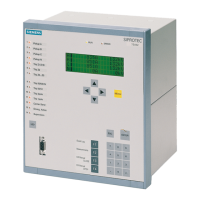1.3 Characteristics
23
7UM61 Manual
C53000-G1176-C127-3
1.3 Characteristics
General Features • Powerful 32-bit microprocessor system.
• Complete digital processing of measured values and control, from sampling and
digitalization of measured quantities to tripping circuit breakers or other switchgear
devices.
• Total electrical separation between the internal processing stages of the device and
the external transformer, control and DC supply circuits of the system because of
the design of the binary inputs, outputs, and the DC converters.
• Simple device operation using the integrated operator and display panel or by
means of a connected PC running DIGSI
®
4.
• Continuous computation and display of measured quantities.
• Storage of fault messages and instantaneous or rms values for fault recording.
• Continuous monitoring of measured values as well as of the hardware and software
of the device.
• Communication with central control and memory storage equipment via serial inter-
faces, optionally via data cable, modem, or optic fibre lines.
• Battery-buffered clock that can be synchronized with an IRIG-B (via satellite) or
DCF77 signal, binary input signal, or system interface command.
• Statistics: Recording of the number of trip signals instigated by the device and
logging of currents switched off last by the device, as well as accumulated short-
circuit currents of each pole of the circuit breaker.
• Operating Hours Counter: Tracking of operating hours of the equipment under load
being protected.
• Commissioning aids such as connection check, field rotation check, status display
of all binary inputs and outputs, and test measurement recording.
Definite Time Over-
current Protection
(I>) with Undervolt-
age Seal-In
• 2 definite time stages I> and I>> for the 3 phase currents (I
L1
, I
L2
, I
L3
).
• Undervoltage seal-in for synchronous machines whose excitation voltage is ob-
tained from the machine terminals;
• Optionally additional directional determination with the high current stage I>>.
• Blocking capability e.g. for reverse-interlocking bus-bar protection with any stage.
Inverse Time Over-
current Protection
(voltage-controlled)
• Selection possible from various characteristics (IEC, ANSI).
• Optionally voltage-controlled or voltage-dependent alteration of current pick-up be-
haviour during undervoltage;
• Voltage influencing can be blocked by fuse failure monitor or via voltage transformer
protective circuit breaker.
Thermal Overload
Protection
• Temperature image of current heat losses (overload protection with full memory ca-
pability, single body thermal model).
• Additional adjustable warning levels based on temperature rise and current magni-
tude.
• Consideration of coolant and ambient temperatures possible.
www . ElectricalPartManuals . com

